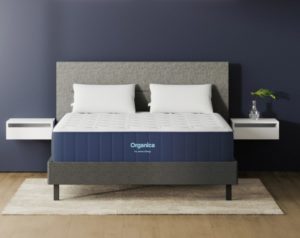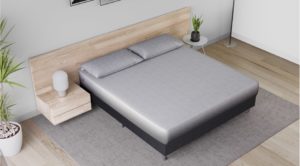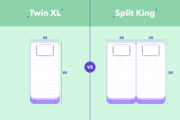Latex vs Memory Foam Mattresses

Memory foam and latex mattresses are often compared to one another. They’re both foams but they have distinctly different characteristics and feels. You can also find mattresses that contain both, allowing you to enjoy the characteristics of each.
If you’re in the market for a new mattress, you’ve got some great options in both the memory foam and latex categories. We’ve done mattress comparisons of each material, so you can see how these foams are different and what you can expect from a mattress that includes them. Hopefully, our guide steers you towards the best mattress for your needs— whether it’s memory foam, latex, or a hybrid model.

Latex Mattresses
The term latex can describe any liquid with tiny polymer particles suspended in it. Latex mattresses are made using either natural latex that’s derived from the rubber tree or synthetic latex that’s composed of manmade materials. Some mattresses contain both natural and synthetic latex in different layers or combined together.
Natural vs Synthetic: What’s the Difference?
Natural latex is found in the milky white sap of the rubber tree. Latex functions as a sealant that protects the tree. After harvesting, the sap must be processed fairly quickly as it can thicken into chunks if left in the open air for too long.
After the latex has been extracted from the sap, it goes through one of two processes— Dunlop or Talalay— to be turned into a mattress. Natural latex mattresses made of either type are made of sustainable resources, making these mattresses some of the most eco-friendly options available.
Instead of coming from plant extracts like natural latex, synthetic latex is derived from petroleum products and synthetic materials. Most synthetic latex used in mattresses is made from styrene-butadiene rubber (SBR). It then goes through the same Dunlop or Talalay manufacturing process to create a latex mattress.
Dunlop vs Talalay: All Latex Isn’t Processed the Same
Natural and synthetic latex have to go through one of two processes before they become a mattress. The first and older of the two is the Dunlop process. A researcher at Dunlop Tyre and Rubber Company discovered the process in 1929, though the first Dunlop latex mattress didn’t come out until 1931. Of course, the process has gone through updates and revisions since then, but it still produces excellent latex.
This process starts by stirring the latex extract into a froth, which is then spread into a mold. The mold bakes in an oven to remove moisture. Next, the latex is removed from the mold and washed. Finally, it’s baked again to get rid of any remaining moisture. During this process, sedimentary material tends to settle at the bottom of the mattress so that one side is denser than the other. Consequently, Dunlop latex mattresses tend to be firmer and denser than Talalay models. Comfort or support layers can be made of Dunlop latex, but because of its higher density, it’s more common as a support layer.
When it comes to Talalay and Dunlop latex foam mattresses, all-natural Dunlop latex mattresses are more eco-friendly than Talalay mattresses. While Talalay latex mattresses are all-natural, the Dunlop process uses fewer steps and resources, making it more eco-friendly in and of itself.
Three Russian brothers Leon, Joseph, and Ansil Talalay invented the newer and more complicated Talalay process. The process starts like the Dunlop process by injecting latex extract into a mold, except the mold is only partially filled. Then, the latex is vacuum-sealed so that it expands to fill the rest of the mold’s available space.
The mold is then flash-frozen to push carbon dioxide into the latex until it fully solidifies. This part of the process helps the latex remain light and aerated. The mattress is then baked and removed from the mold. It still has to be washed and dried again before it’s finally done.
The process may be more laborious, but it creates a lighter mattress with an even density. Talalay latex is lighter, softer, and bouncier than Dunlop, making it more appropriate for comfort layers. Both processes can be altered to create mattresses of different firmnesses. However, in general, Dunlop latex is denser, firmer, and less conforming than Talalay latex.
You can find all-latex mattresses, latex hybrids, and mixed-foam mattresses that contain latex layers. Latex is more breathable than memory foam, but it can trap body heat. Many mattress manufacturers aerate their mattresses by creating aeration channels in the foam while still in the mold.
Latex mattresses don’t conform to the body the way memory foam does, although they do cushion and hug body curves. They provide an experience that’s more like sleeping on rather than in the mattress.
Best Latex Mattress: Amerisleep’s Organica
Amerisleep is known for their high-quality memory foam mattresses. However, they just recently released a latex mattress called, Organica. This bed has a hybrid design with pocketed spring coils and a latex foam comfort layer. The medium firmness makes this mattress ideal for most sleep styles and body types.
The cover of the Organica mattress is made with GOTS (Global Organic Textile Standard) certified organic cotton, guaranteeing it is free of harmful pesticides and chemicals that could irritate the skin and lungs. This cover is also perforated for maximum breathability and protection against night sweats.
The layer of organic Joma Wool® just beneath the cover provides further protection against heat retention and acts as a natural fire barrier. By using wool for fire resistance, Amerisleep doesn’t need to rely on toxic chemicals, such as formaldehyde.
The top layer features Amerisleep’s all-natural Talalay latex foam. This material is certified by the eco-Institut and the Rainforest Alliance to be sustainably harvested and manufactured. The natural bounce of latex foam is perfect for back sleepers, those with back pain, and heavier individuals because it prevents over-sinking and ensures the spine remains in a safe, neutral position.
The base of the Organica mattress features Amerisleep’s pocketed spring coils. The independent movement of these coils reduces motion transfer, noise, and increases contouring. With this stable base, body weight stays evenly distributed and the joints remain cradled and protected from pressure points.
Like all Amerisleep mattresses, the Organica comes with free shipping, a 100-night sleep trial, and a 20- year warranty.
Amerisleep Organica
- GOTS certified organic cotton cover
- All-natural Talalay latex comfort layer
- Pocketed spring coil base
Memory Foam Mattresses
NASA originally invented memory foam for seating in space shuttles. However, it made its way into the mattress market back in the 90s. People loved its ability to relieve pressure and cradle the body. Today’s memory foams have many of the same qualities but with some significant improvements.
Memory foam always starts as polyurethane but has other add-ins, depending on the formula. However, many mattresses contain poly-foam, which is also made from polyurethane. While all memory foams contain polyurethane, not all polyurethane foams are memory foam.
Each manufacturer has their own process and formula to create their special blend. They treat the polyurethane with either synthetic chemicals and/or plant-based oils to create a dense, energy-absorbing foam.
Memory foam is heat and pressure-sensitive. It softens as it gets warmer, so the conformability increases the longer it’s in contact with heat and pressure. Basically, your body sinks more deeply into its surface the longer you lay on it. It’s also a slow responding foam. That means you’ll be able to see the distinct outline of your hand in it for a while before it returns to its original shape.
Memory foam mattresses have some impressive strengths. Memory foam can be made in many densities for use in a mattress’s comfort and transition layers. Memory foam mattresses are quiet, incredible at motion isolation, and offer excellent pressure relief. Some memory foam mattresses have several types of foam in their layers, including latex and poly-foam. The comfort layers of many innerspring hybrid mattresses also consist of memory foam.
Memory Foam Cell Structure: It Matters
Early memory foam mattresses trapped heat with their dense, closed-cell structure. Closed-cells don’t allow air or heat to pass through, trapping it against the body. Because memory foam contours closely to the body, trapped heat becomes an issue.
Some manufacturers have attempted to solve this problem by creating memory foams with an open-cell structure. Larger individual cells in the foam have more space for heat to escape. Despite their extra “airiness,” open-cell foams remain durable. They also improve the responsiveness of the memory foam, so sleepers are less likely to feel “stuck” in the mattress.
Cooling Technologies
Open-cell foam isn’t the only way manufacturers adapt their memory foam formulas to improve sleeper comfort. Here are some other common additions and techniques used to improve airflow and breathability.
- Gel: Gel beads infused into the memory foam absorb heat and move it away from the body. Some manufacturers also incorporate a gel layer over the memory foam for further cooling. Our gel memory foam vs latex guide compares the two materials.
- Copper: Copper beads, an excellent heat absorber, conduct heat away from the body and out of the mattress.
- Graphite: Like gel and copper, graphite beads absorb and dissipate heat.
- Convoluted structure: If you’ve ever seen an eggshell foam pad, you’ve seen foam with a convoluted structure. The valleys and peaks of this design leave space for more air to pass through, increasing breathability.
- Channeled designs: Memory foams with channeled designs work similarly to those with convoluted structures. The channels create space for the heat and air to move so the body can breathe.
Manufacturers combine many of these techniques and technologies to cool sleepers. They may use a gel-infused memory foam layer with a traditional memory foam layer underneath. Some mattresses have both memory foam and latex foam layers to get the conforming benefits of memory foam and combine it with the responsiveness and breathability of latex.
Best Memory Foam Mattress: Zoma Mattress
For a high-quality memory foam mattress with minimal heat retention, we recommend the Zoma Mattress. This bed has a gel memory foam comfort layer that pulls heat and moisture away from the sleeper for a cooler, more comfortable night’s sleep.
While Zoma’s unique memory foam conforms to the body for instant pressure relief, it won’t cause night sweats or over-heating. The medium feel of this foam is perfect for side, back, and combination sleepers.
While the comfort layer molds to the body for pressure relief, the transition layer with Triangulex™ ensures the lumbar spine is supported to prevent excess sinking and spinal misalignment. This latex-like foam keeps the hips and shoulders level so the muscles in the back can fully relax and recover during sleep.
The stable foam base of the Zoma features their Support+ foam to prevent sagging and indentations. This base promotes a healthy sleep posture and increases the lifespan of the mattress.
The Zoma Mattress comes with free shipping, a 100-night sleep trial, and a 10-year limited warranty.
Zoma Mattress
- Gel-infused memory foam top layer
- Responsive transition layer for a neutral spine
- Stable foam base is resistant to sagging
Memory Foam vs Latex Mattresses: The Comparison
Many people get a comfortable night’s rest on memory foam and latex mattresses. The question is, which one is right for you? The answer lies in what you want from your mattress. These two foams are different in what they offer sleepers. Here’s a rundown on what you can expect from each:
Latex Foam Pros:
- Conforms without completely molding to body shape, leaving the sleeper on top of the mattress
- Responsive and bouncy
- Can be all-natural
- Highly durable (synthetic latex is less durable than natural)
- Can be eco-friendly
- Less heat retention, especially when aerated
- A hypoallergenic mattress, unless you have a latex allergy (synthetic latex does not trigger latex allergies because it’s not made of natural latex)
Latex Foam Cons:
- Expensive
- Can have a rubbery odor
Memory Foam Pros:
- Molds to the shape of your body
- Softens and molds more deeply with heat and pressure
- Minimal motion transfer
- Quiet
- Highly durable as long as it’s high-quality
- Less expensive than latex
- Even, responsive sleeping surface
- Excellent cooling technologies improve temperature regulation
Memory Foam Cons:
- Can be warm without the help of cooling technologies
- Initial off-gassing odor (does dissipate)
- Leaves some sleepers feeling stuck in the mattress
FAQs
Is latex cooler than memory foam?
In general, latex foam tends to be more breathable than memory foam. However, mattress manufactures are now producing memory foam with just as much breathability as latex foam. Plant-based memory foams and gel or graphite-infused foams retain less heat and moisture than traditional memory foam.
Is there latex in memory foam?
Most memory foam does not contain latex. However, it is important to understand the brand’s foam construction to determine its overall comfort level. Some latex foam varieties contain synthetic chemicals to make them feel similar to memory foam.
Is latex good for side sleepers?
Yes. Latex foam mattresses can be made in many different firmness levels, some of which are suitable for side sleepers. In most cases, soft to medium latex mattresses are best for side sleepers.
Can I sleep on a latex mattress if I’m allergic to latex?
We recommend avoiding latex mattresses if you have a latex allergy. While some people with latex allergies find that a waterproof mattress protector is enough to protect them from a reaction, it is best to discuss this with your doctor first.
Is the smell of latex harmful?
Most foam mattresses, such as memory foam and latex foam beds, have a slight odor when they are first brought indoors. This is due to the VOC (Volatile Organic Compounds) that leach from the mattress as it expands. In most cases, this odor is not harmful and will dissipate within few days.
Latex vs Memory Foam Mattress: Who Are They For?
Both materials can provide a comfortable, cool night’s rest with the right model. Which one is right for you will depend on what you’re looking for in a mattress. A latex mattress is a good option if you want more bounce, quick responsiveness, and a low carbon footprint. Latex is also great if you’re looking for an eco-friendly, organic mattress.
However, the best mattresses for side sleepers are usually memory foam as they provide deep contouring and pressure point relief. And, while latex can be made in different firmnesses, you have more comfort options with memory foam mattresses.
You can find high-quality beds made of both of these materials, including mixed foam and hybrid mattresses. As you’re looking for a new mattress, consider what you need most from your bed. That can narrow down your choices and make sure you end up with a model that will help you get a wonderfully comfortable night’s rest.





